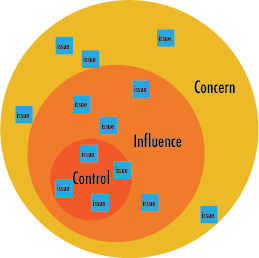Three Radically Simple Steps for Using a “Spheres of Influence” Analysis
It’s easy to get to the end of a Five Whys analysis and feel overwhelmed.
An expanded Five Whys approach can uncover dozens — if not hundreds — of root causes to the problems and puzzles you’re trying to solve. And it’s not out of the ordinary to uncover a few root causes that are too big and complex for anyone to ever “solve” all at once.
Pairing a “Spheres of Influence” Analysis with a Five Whys Analysis can help you sort out the underlying issues that are within your immediate control, the issues that you can only influence from a distance, and the issues that are simply beyond your ability to do anything about directly in the near term.
A Spheres of Influence Analysis can point the way toward interventions that are quick, affordable, or easy to accomplish — actions that are within your control and may prevent the issues you’ve been wrestling with before they even begin. The same exercise can keep you from spinning your wheels trying to solve problems that will require more time, resources, and power than you have on hand.
Here are three steps for using a Spheres of Influence Analysis to sort and activate the outcomes of an expanded Five Whys Analysis:
Step One: Set Up the Spheres of Control, Influence, and Concern
On a white board or a large sheet of paper, draw three concentric circles. Label the center circle “control,” the middle circle “influence,” and the largest circle “concern.”
The first circle, “control,” is a container for all the underlying issues you or your close collaborators can immediately get to work solving and have a reasonable expectation of succeeding in the near term.
The second circle, “influence,” is a container for all the underlying issues you can’t solve right away, but you might have the ability to influence indirectly with some degree of confidence that your efforts will pay off.
The third circle, “concern,” is a container for all the underlying issues you can’t control and have little hope of ever directly or indirectly changing alone or even with the help of close collaborators.
Step Two: Sort Your Sticky Notes
If you used sticky notes or cards to write out each underlying issue you surfaced in your Five Whys Analysis, you can move each note into one of the three concentric circles you drew in step one. Take your time to sort out all the issues from your Five Whys Analysis. This step often leads people to identify more underlying issues — go ahead and jot any new ideas down on more sticky notes and sort those, too.
Step Three: Take Stock
Once you’ve sorted all the underlying issues from your Five Whys Analysis into the Spheres of Control, Influence, and Concern, step back and take stock of the results. Ask yourself:
What might happen to the overarching problem I’m trying to solve if I tackle all the underlying issues within my sphere of immediate control?
Who would you need to collaborate with to begin addressing the issues in your sphere of influence? Who has more direct control of the issues you can only influence from a distance? What steps can you take today that may solve an underlying problem later on?
What are the unavoidable underlying issues I need to accept and adapt to for now? Are there any steps me, my team, or my organization can take to mitigate the problems caused by issues in my Sphere of Concern?
Note: Acceptance is not the same as acquiescence.
We will all face big, unwieldy problems in our work that none of us can solve directly on our own.
Knowing these constraints can help us save our limited resources to tackle the issues that we can solve. More importantly, knowing that some of the problems we seek to solve are fueled by giant underlying issues outside our control keeps us humble and calls us to work collaboratively with others to create change.



